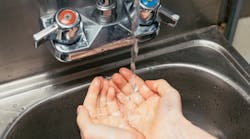Sanitation in food processing has mostly been a matter of food safety. The coronavirus situation has raised the stakes: Now sanitation is also a matter of worker safety.
Joel Cook, senior technical manager at Hydrite Chemical, recommends that customers consult this EPA list, while noting that, because it’s a new virus, few tests on cleaner efficacy have been done.
Gloves get fingered
However, while the chemicals may not change, some standard sanitation procedures and equipment are getting at least a second look – even something as seemingly simple as disposable gloves.
Overall demand is increasing for the disposable gloves supplied by Eagle Protect, says CEO Steve Ardagh. Perhaps just as importantly, customers are paying more attention to the quality of the gloves they furnish their staff.
“People think a glove is a glove,” Ardagh says. “Not so.” Gloves must be FDA-compliant, but all that means, he says, is that they don’t contain certain harmful chemical or leach any chemicals onto food. It doesn’t say anything about durability, for instance. Many of the disposable gloves used in food processing and similar industries are made of vinyl, which often tears; Eagle’s gloves are made of nitrile (artificial latex), which is more expensive but more durable.
Ardagh notes that gloves must be as durable as an application requires: handling frozen steaks, for instance, requires stronger gloves than handling freshly cooked pancakes. But he said durability does not necessarily correlate to thickness. “On numerous occasions we’ve given people gloves half the thickness and it’s been better than the one they’ve been using.”
For instance, using chalk in the material formulation, which is often done to save money, makes the glove weaker.
“One of the positive things to my mind from this outbreak is, there’s going to be a huge focus on hand and glove hygiene,” Ardagh says.
Wash up
That focus extends to what’s probably the simplest, and most pervasive, all-purpose piece of advice for dealing with coronavirus: Wash your hands, thoroughly and often.
Hand washing has always been an integral part of food plant hygiene. Now the coronavirus has made this imperative for the safety of fellow workers, as well as the food they handle. For decades, automatic systems have reduced the human variability factor in hand washing, by both systematizing the process and allowing it to be tracked. Makers of such systems say they’re now getting more interest than ever.
“Absolutely,” says Paul Barnhill, chief technology officer of Meritech. “We have been working closely with our customers and food processing leaders to empower them with the tools they need to ensure effective hygiene and maintain operations during the COVID-19 pandemic.”
Sanitation stations can use turnstiles to ensure hand-washing and other procedures.
Photo: Elpress BV
Some automated hand-washing systems incorporate features like making employees punch in a code or swipe or tap an ID card to activate, allowing the system to track use. Some companies are carrying the concept a step further, by establishing “hygienic locks”: barriers that isolate employees and don’t allow them to proceed until they wash their hands or perform some other hygiene-related task.
“Now many companies have adopted a mandatory mini-break where each worker is given a new facemask and must pass through a hygienic lock,” says Marco Bruno, export and key account manager for Elpress BV.
Some companies have lists, sometimes administered by a manager, who checks off employees’ names as they wash up. But this is inefficient and labor-intensive.
“With modern hygienic locks this problem is surpassed with a pass/no pass system where if the employee washes their hands then they can pass to the next step in the process; and if they don’t, they are blocked behind a turnstile,” Bruno says.
“As a second layer of control we can also integrate the hand-washing and disinfecting with a company’s QA system via badge or biometric readers. This system then guarantees that a certain hygienic protocol has been respected to the level of every single employee. This information can then be shared with external auditors or customers.”
Cleaning gaps
Personal sanitation by itself can’t make a plant safe, of course. Sanitation of equipment, floors and other surfaces in a plant are just as important. And, like personal sanitation, when done with standard techniques and chemicals, sanitation of equipment and other surfaces is likely to eradicate SARS-CoV-2 along with other microbes. The difference, however, is that it’s easier to make workers wash their hands more often; stepping up the frequency of surface sanitation sometimes isn’t so simple.
Most plants have sanitation protocols built into their standard operating procedures. These are usually designed to purge traces of a given product or ingredient between changeovers, preventing the buildup of residue that could either contaminate product directly or harbor microorganisms.
The problem is that these sanitation applications often are done at the end of a product run or a shift – intervals that can last eight hours or more. When spaced out like that, sanitation is of limited use in preventing worker-to-worker transmission of coronavirus.
Many processors are increasing sanitation where they can, in places like break rooms and washrooms. The danger of person-to-person transmission is no less in those places than it is in the production area – it may even be greater, since workers tend to shed protective gear before they enter common areas.
“Our customers are paying special attention at this time to cleaning and disinfecting common areas of their facilities (offices, break rooms, etc.),” says Jake Watts, vice president of food safety for PSSI. “PSSI recommends routine cleaning of all frequently touched surfaces in the workplace, such as workstations, counter tops, and doorknobs.”
Some plants are sanitizing production areas more often when they can. But if sanitation of the production area can only be done every few hours, or once a day, at least it can be done with extra thoroughness. Providers of sanitation supplies report an added interest in deep cleaning, whether at the end of the regular workday or in plants that were closed due to coronavirus exposure.
The coronavirus situation has sharpened focus on both sanitation application equipment and the chemicals it uses.
Photo: Goodway Technologies
“We designate team members with appropriate PPE [personal protective equipment] to effectively fog/mist the potentially affected areas within the facility prior to conducting our ‘8 Steps of Wet Sanitation,’ "Watts says. “For added protection against the spread of the virus, we also deploy the 8 Steps of Dry Sanitation to all communal areas after areas are fogged/misted during high risk mitigation situations.”
Tim Robb, vice president for marketing and strategic business development at Goodway Technologies, says that deep cleaning in a plant isn’t that different from that in a home.
“Deep cleaning in a commercial or industrial environment is similar in scope to that of a residential home; just in a much bigger setting,” Robb says. “It means getting into all the spots that rarely (if ever) get cleaned.” That includes areas behind machinery; exposed vents and drains; the top of lighting; heating and cooling systems, including ductwork, grilles and diffusers; and electronics.
Feeling the heat
Water used for sanitation, whether of hands or equipment, must usually be heated. An alternative to heating water at a central point like a boiler is a decentralized system of direct steam injection. Localized water heating often makes sense, especially in applications where hot water is not needed for processing.
Steam injection systems can deliver a reliable, localized supply of heated water for sanitation.
Photo: Pick Heaters
“An advanced steam injection system like Pick is instantaneous and uses only a fraction of the floor (or wall) space of bulky storage tanks, freeing up valuable space for other equipment,” says Phil Sutter, co-president of Pick Heaters. Direct steam injection “is extremely responsive to process changes and far more energy efficient since water is only heated on demand, when it’s needed.”
Sean Fulton, vice president of sales at Hydro-Thermal, quantifies the energy savings of direct steam injection this way: “The results are more rapid heat transfer and more efficient energy use than heat exchangers. In fact, energy savings can be considerable, reductions in the 20-25% range are not uncommon.”
The coronavirus situation can serve as a motivation to maintain and improve good sanitation practices – perhaps beyond the immediate crisis.
Says Meritech’s Barnhill: “We must remember to maintain this level of awareness and behavior change even after the COVID-19 pandemic is over in order to prevent the likelihood that other outbreaks will reach such devastating heights in the future.”


